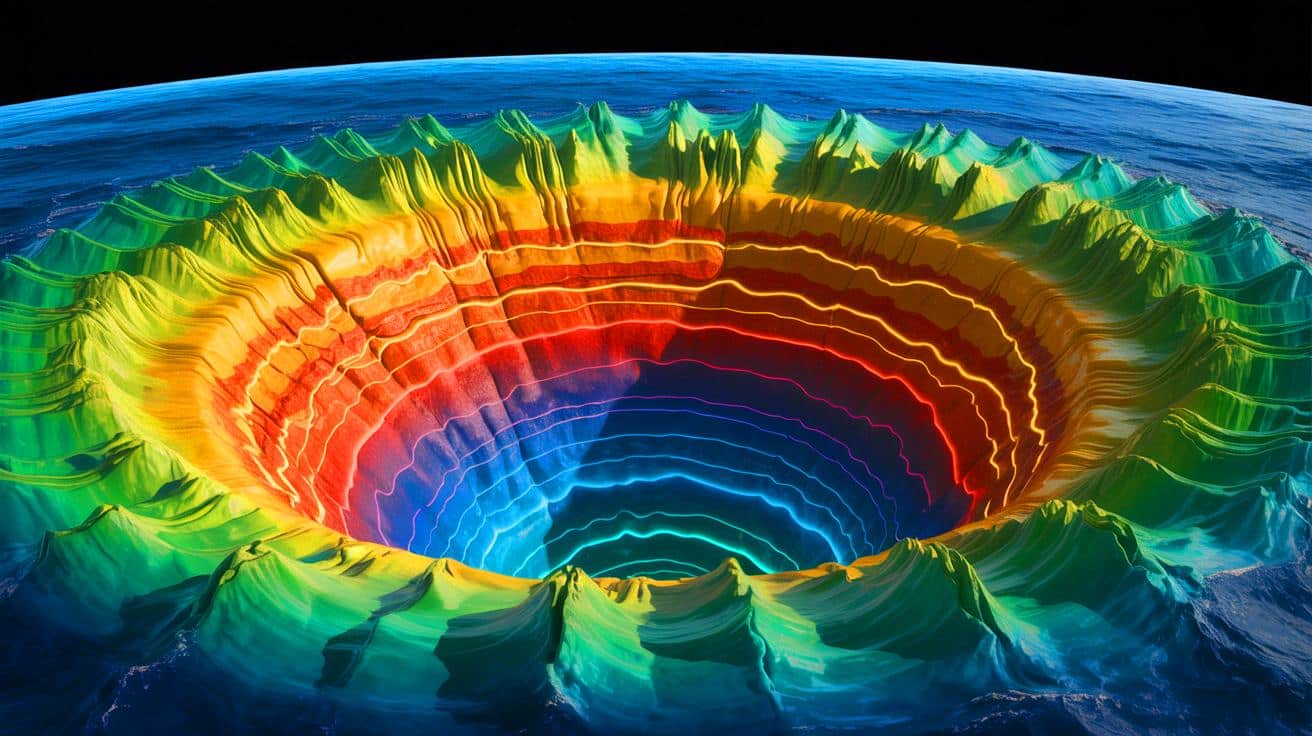IN A NUTSHELL
🌍 Scientists discover mysterious structures beneath the Pacific Ocean challenging current geological models.
🔍 New techniques like full-waveform inversion provide deeper insights into Earth’s mantle.
🧩 Findings suggest the presence of ancient tectonic fragments in unexpected locations.
🌋 Understanding these structures could impact our knowledge of volcanic activity and tectonic cycles.
The Earth beneath our feet conceals mysteries that have long intrigued scientists. While surface exploration has advanced considerably, the inner workings of our planet remain largely elusive. The mantle, accounting for the majority of Earth’s volume, is especially enigmatic. Recent advancements, however, have begun to shed light on these hidden depths. A team of geophysicists has uncovered unexpected signals emanating from the Pacific, suggesting the existence of structures that defy current geological understanding. These discoveries challenge established models and open new avenues of inquiry into the dynamics of Earth’s interior.
The Mantle Speaks: Unexpected Discoveries Beneath Our Feet
For decades, geophysical studies of the mantle were limited to analyzing specific types of seismic waves. This approach offered a partial view, akin to a limited ultrasound. The introduction of full-waveform inversion has revolutionized this field. By analyzing all seismic waves generated by earthquakes, this technique provides a more comprehensive picture. The process requires immense computational power, utilizing supercomputers to handle the vast data sets.
Thomas Schouten and his team from the Institute of Geology at ETH Zurich, in collaboration with the California Institute of Technology, have applied this method to the lower mantle. Their findings were surprising. In areas where current models suggested no geological activity, they detected fragments resembling tectonic plates. This was particularly evident in the Western Pacific, a region previously thought to be devoid of such features.
The Earth Hides Secrets No One Expected to Find
Seismic waves, by traveling at varying speeds through the mantle, reveal differences in rock density and rigidity. However, the causes of these variations remain elusive. According to Schouten:
“With the new high-resolution model, we can see such anomalies everywhere in Earth’s mantle. But we don’t know exactly what they are or what material is creating the patterns we’ve uncovered.”
https://www.rudebaguette.com/en/2025/05/continent-is-sinking-north-americas-ancient-bedrock-is-gradually-slipping-into-earths-mantle-alarming-geologists-worldwide/
Several hypotheses have emerged:
Ancient fragments of subducted plates: These could be remnants of plates that sank beyond collision zones, preserved for over 200 million years.
Primordial silica-rich pockets: These might be pieces of the original mantle that resisted convective flow since Earth’s formation approximately 4 billion years ago.
Accumulations of iron-rich rocks: Over billions of years, internal movement may have created anomalous densities.
Professor Andreas Fichtner from ETH Zurich likens the discovery to a doctor using a new tool to find unexpected arteries, highlighting the profound nature of these findings.
What the Hidden Mantle Could Mean for Our Planet
Understanding the mantle’s hidden structures is crucial, as they can have significant implications for Earth’s surface phenomena. These structures could influence:
The flow of heat within the planet: This could alter convective currents that drive continental movement.
The formation of mantle plumes: These plumes are responsible for volcanic hotspots, such as those in Hawaii.
The tectonic cycle: The discovery of tectonic fragments outside known subduction zones necessitates a reevaluation of plate dynamics.
Despite recognizing the existence of these anomalous structures, their precise nature remains unclear. Future research will combine various methods, including electromagnetic data and laboratory experiments, alongside increasingly powerful supercomputers, to enhance our understanding.
New Tools, New Insights: The Future of Mantle Research
As technology advances, so does our ability to explore the Earth’s interior. The use of supercomputers and sophisticated modeling techniques represents a significant leap forward in geophysical research. These tools enable researchers to construct detailed models of the mantle, offering insights that were previously unattainable. The findings in the Pacific are just the beginning. By integrating diverse data sources and refining analytical techniques, scientists hope to unravel the complexities of Earth’s inner workings.
The implications of these discoveries extend beyond academic curiosity. Understanding the mantle’s dynamics can inform our knowledge of seismic activity, volcanic eruptions, and even climate patterns. As research progresses, the potential for groundbreaking revelations grows, challenging our perceptions of the planet we call home.
The exploration of Earth’s mantle is a journey into the unknown. As new techniques reveal hidden structures, we are reminded of the vastness and complexity of our planet. These discoveries prompt us to reconsider long-held beliefs and open new avenues for research. What other secrets lie beneath our feet, waiting to be uncovered by the next generation of scientists?
This article is based on verified sources and supported by editorial technologies.
Did you like it? 4.5/5 (30)

